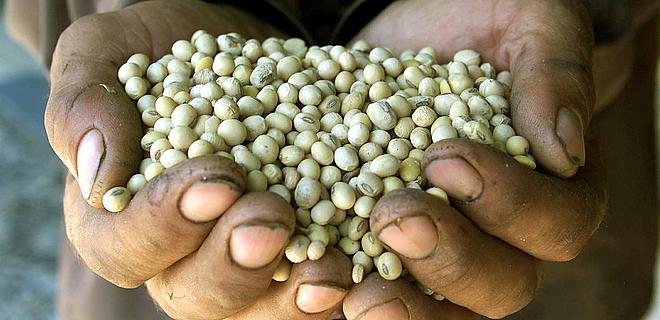This article was originally published in Grainews
I don’t know enough about the issue to strip it down to its bones. Few do, it seems. But I do understand what sides, polarities, and knee-jerk reactions are. I’ve lived among those who equate genetically modifying anything to murder — murder committed by someone who hates the earth and loves Monsanto. These people walk among us, and, guess what? They are smart, rational human beings. But they have natural enemies. The coffee-shop farmers and ag-industry shills who pigeonhole GMO naysayers as hippies, idiots, or — the other pejorative — city folk.
Hilarious. All of it. And, wrong, on both sides.
Needed background and a confession: I’ve already committed a fallacy in this article. Perhaps two, but let’s focus on the most obvious one. The straw man fallacy is a sly move where the person attempting to make a point falsely represents opposing arguments, making them weaker than they really are. I did this. Apologies. Brilliant articles have been written in favour of GMO products and crops. And equally smart arguments have been made in opposition. It’s a good fallacy to keep in mind when you’re listening to politicians, watching commercials, or in throes of heated debate. And watch for it during your next conversation about GMOs.
If I have an agenda here, it’s to champion the middle. The answer to the issue is caution, and it exists somewhere in the middle. So, let’s wallow in the grey for a little while. This is the place where, “I’m not sure,” has the gravity I think it deserves on the issue of GMOs.
There is nothing about sitting “genetics” and “modification” next to each other that isn’t terrifying. It’s tampering, and that is a scary word. Can we agree on that? Let’s move on.
The debate
I put the question of GMOs to a group of colleagues, and got many responses, some of them thoughtful, some of them reading like undergrad essays.
Here’s what Respondent No. 1 said: “There’s no scientific basis for opposition, and we live in a world where plenty of people still haven’t got enough to eat. Given these two facts, I can’t see a good reason not to allow GMOs.”
This responder is right about the food deficit. A reported two billion people are hungry on this planet, according to a 2014 article appearing in Forbes, which went on to say, that the world’s population is expected to rise from the current seven billion to nine billion by 2050. Current food production and practices, the article claimed, will not be enough to meet this need.
We grow food on our farm — wheat and soybeans. Our production includes GMOs, and it does so unceremoniously.
The hoe drill wasn’t ready for the field. We had to untarp it, grease all the zerks, and make sure the proper seeding rates were set. The seed was already bought, and it was bought with absolutely no ceremony. I don’t yet make the decisions, but from my perspective, the choice to grow Roundup Ready soybeans was made without malice to the earth or a deliberate attempt to side with Monsanto in a public debate.
I think it would have been difficult for our farm to find soybean seed that wasn’t Roundup Ready. It’s what’s available. Farmers are not planting these seeds with a maniacal smirk.
I seeded this year, handling the bright blue soybean seed that was not only genetically modified but also covered in inoculant. I put in long days in spring doing so. While on the field, I did not think about the good work I was doing meeting a looming or present food deficit, the policy complexities surrounding GMOs, nor the fact that I was unwittingly consenting to the modification of genetics. I was just seeding, and my mind was bent towards ensuring the seed was flowing at the appropriate rate into the ground.
We sprayed the beans with Roundup three times before harvest. They looked great, yielded really well, and are now the congested market’s problem.
It angers farmers and frustrates me to read articles painting my ag colleagues and me as cold, Machiavellian, calloused. And these are the pieces that make it to the coffee shops.
We’re not a thoughtless bunch. The very same farmers planting these genetically modified crops have real thoughts on the issue.
“It’s a young science,” said a farmer sitting at The Oasis in Winkler, Man., for his daily 7:00 a.m. coffee. “I think we should be planting these crops, but we should also be wary of the fact that the long-term effects of these modifications on humans may yet reveal something negative.”
Seedless watermelon and other practices closely representing plant eugenics have been around for a while. That science is not young, but Roundup resistance is.
In 1996, Roundup resistant soybeans hit the market. In 1997, Monsanto introduced similar modifications to cotton and canoloa. And, in 1998, corn.
“I’m not convinced about the dangers of GMO-related health threats… because science,” said Responder No. 2. “However, I am concerned about multi-nationals owning patent rights to seed, which pushes all potential farmers to big-business models. I also have issues with public subsidy of big-business food production and its subsequent devaluation of food in the market. I think this is directly related to why we can’t open/keep a grocery downtown with margins for small businesses being so slim. Then access becomes a problem, then our neighbourhoods are built around large food distribution.”
This is an important perspective for us farmers to consider, wresting their minds from the farm to further down the chain: The pockets of density that actually consume the products we grow.
We need to proceed. But we need to proceed with caution.
This agnostic position on GMOs capitalizes on the conversation started by those with a strong no, and those with strong yes. And the conversation is very important.
—
Toban Dyck is a writer and a farmer.
